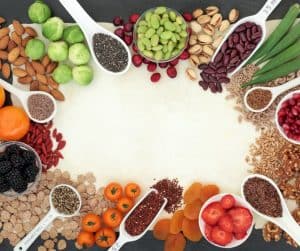
To keep your energy sustained, it is important to maintain blood sugar control. Natural blood sugar control is possible when done correctly and with professional guidance and supervision. When individuals fail to fuel themselves properly, they may experience reactive hypoglycemia (low blood sugar) or dysglycaemia (abnormal blood sugar levels) with an exaggerated insulin response. As a result, there is a subsequent dramatic drop in blood glucose, causing physical and emotional symptoms (see below). When blood glucose levels become unstable we can feel like we are on an energy roller-coaster throughout the day.
Symptoms can mimic other common issues such as anxiety or even menopause.
Symptoms of blood sugar dysregulation:
Thyroid issues, hormonal imbalances, or high exercise demands can exaggerate these symptoms, especially with inadequate fueling in between multiple daily training sessions. There are a number of simple steps that may help stabilise blood sugar.
1. Protein is essential to blood sugar stabilisation and should be included in every meal including breakfast. Quality protein can be found in lean animal meats (kangaroo, lamb, beef, chicken) and fish. Vegetarian options include tofu, tempeh, legumes, eggs, dairy, and high-protein grains such as quinoa, buckwheat and amaranth. Vegans and vegetarians must practice protein source combinations to obtain all the essential amino acids.. For example: consume chickpeas with brown rice.
Athletes should ideally consume 1.2-1.6 grams of protein/kilogram of body weight which equates to 60-80 grams of protein for a 50kg female and 90-128 grams for an 80kg male athlete per day. It is beneficial to have 20 grams of protein with carbohydrates within 30- 60 minutes of completing a training session. A good option is a smoothie with a scoop of protein powder (pea, brown rice or whey if tolerated), a small can of tuna or 2-3 eggs.
2. Carbohydrates
Intake of low GI (Glycemic Index) carbohydrates will help keep blood sugar levels more sustained, and energy levels consistent. A high GI carbohydrate will cause a surge in blood glucose, triggering a response from the pancreas. This can contribute to the symptoms described previously.
Good sources of complex carbohydrates include porridge, Bircher muesli, brown, basmati or wild rice, barley, oats, buckwheat, quinoa, amaranth, teff, rye, sweet potato, and root vegetables with skins on. Sourdough bread, corn on the cob, bananas, fruit smoothies with protein powder, and homemade muffins using wholemeal flours such as hemp, chia or buckwheat are all good options. Consuming carbohydrates with quality fats and soluble fibre also reduces the GI of foods.
3. Magnesium
Magnesium assists with blood sugar control by supporting healthy insulin secretion.
Magnesium is abundant in amaranth (a grain), pumpkin seeds, dark chocolate and raw cocoa, wholemeal bread, quinoa, firm tofu and dark leafy vegetables. It is also found in oat bran, brown rice, cooked spinach, avocado, coconut water, kale, legumes, sesame seeds and cashews.
4. Chromium
Chromium deficiency reduces your body’s ability to use carbohydrates for energy and raises your insulin needs. Chromium may enhance the effects of insulin or support the activity of pancreatic cells that produce insulin. Chromium is found in meats, fish, poultry, wholegrains, dairy, broccoli, cheese, mushrooms, asparagus, green beans, apples, bananas, grape juice and potato.
5. Probiotics
Probiotics especially those containing more than one species of beneficial bacteria may help regulate blood sugar by influencing the way the body metabolises carbohydrates by reducing inflammation and preventing the destruction of pancreatic cells that make insulin.
Maintaining energy throughout the day
Always seek help from a healthcare practitioner if your symptoms persist.
About the Author: Kate Smyth is a Sports naturopath, nutritionist and female-centric running coach. She is the founder of the Athlete Sanctuary- a holistic healthcare clinic for athletes of all levels and sporting codes. Kate has a thirst for knowledge with two bachelor’s and a master’s degree under her belt. She has been involved in sports for many decades and competed for Australia in the Commonwealth Games and Olympic Games marathons with a personal best time of 2 hours 28 minutes. For more information visit https://athletesanctuary.com.au/kate-smyth

Kate Smyth is a sports naturopath, nutritionist and female-centric running coach. She is the founder of the Athlete Sanctuary – a holistic healthcare clinic for athletes of all levels and sporting codes.
Kate has a thirst for knowledge, with two bachelor’s and a master’s degree under her belt. She has been involved in sports for many decades and competed for Australia in the Commonwealth Games and Olympic Games marathons with a personal best time of 2 hours 28 minutes.
Targeted naturopathic care, nutrition and holistic coaching for active individuals.
Normatec Recovery systems- hire and purchase
Birregurra -28-30 Strachan Street,
Torquay- 20 Cantala Drive, Jan Juc
TELEHEALTH – Aus wide, New Zealand, Canada and globally (except US)
Melbourne and Ballarat clinics are currently online